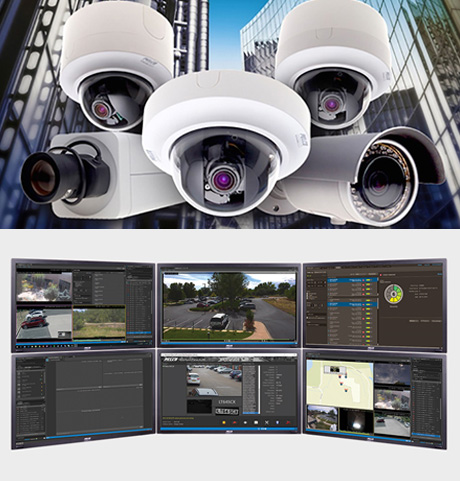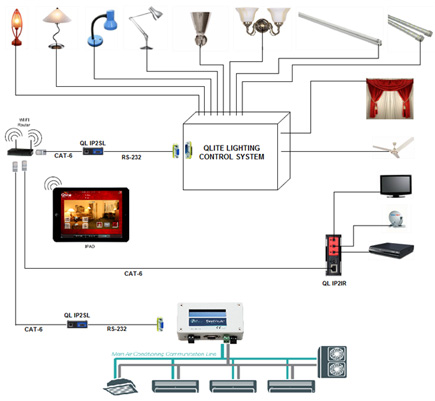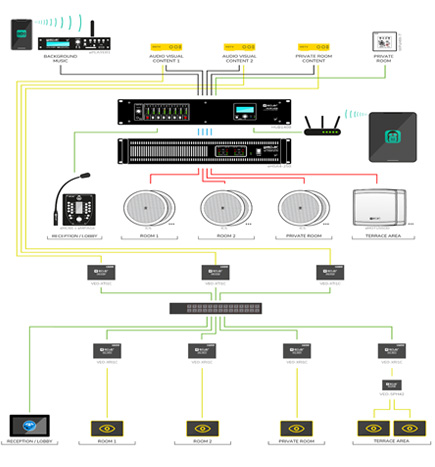ELV SOLUTIONS

IP CCTV System
Closed-circuit television (CCTV) is the use of video cameras to transmit a signal to a specific place, on a limited set of monitors. It differs from broadcast television in that the signal is not openly transmitted, though it may employ point to point (P2P), point to multipoint, or mesh wireless links. Though almost all video cameras fit this definition, the term is most often applied to those used for surveillance in areas that may need monitoring such as banks, casinos, airports, military installations, and convenience stores. Videotelephony is seldom called "CCTV" but the use of video in distance education, where it is an important tool, is often so called.
1. Analogue: Can record straight to a video tape recorder which are able to record analogue signals as pictures. If the analogue signals are recorded to tape, then the tape must run at a very slow speed in order to operate continuously. This is because in order to allow a three-hour tape to run for 24 hours, it must be set to run on a time lapse basis which is usually about four frames a second. In one second, the camera scene can change dramatically. A person for example can have walked a distance of 1 meter, and therefore if the distance is divided into four parts, i.e. four frames or "snapshots" in time, then each frame invariably looks like a blur, unless the subject keeps relatively still.
2. Digital: These cameras do not require a video capture card because they work using a digital signal which can be saved directly to a computer. The signal is compressed 5:1, but DVD quality can be achieved with more compression (MPEG-2 is standard for DVD-video, and has a higher compression ratio than 5:1, with a slightly lower video quality than 5:1 at best, and is adjustable for the amount of space to be taken up versus the quality of picture needed or desired). The highest picture quality of DVD is only slightly lower than the quality of basic 5:1-compression DV.
3. Network Camera: IP cameras or network cameras are analogue or digital video cameras, plus an embedded video server having an IP address, capable of streaming the video (and sometimes, even audio).
4. ANPR Camera: Automatic number-plate recognition (ANPR; see also other names below) is a technology that uses optical character recognition on images to read vehicle registration plates to create vehicle location data. Systems commonly use infrared lighting to allow the camera to take the picture at any time of day or night
Because network cameras are embedded devices, and do not need to output an analogue signal, resolutions higher than CCTV analogue cameras are possible. A typical analogue CCTV camera has a PAL (768×576 pixels) or NTSC (720×480 pixels), whereas network cameras may have VGA (640×480 pixels), SVGA (800×600 pixels) or quad-VGA (1280×960 pixels, also referred to as "megapixel") resolutions.

Access Control System
In the fields of physical security and information security, access control is the selective restriction of access to a place or other resource. The act of accessing may mean consuming, entering, or using. Permission to access a resource is called authorization.
When a credential is presented to a reader, the reader sends the credential’s information, usually a number, to a control panel, a highly reliable processor. The control panel compares the credential's number to an access control list, grants or denies the presented request, and sends a transaction log to a database. When access is denied based on the access control list, the door remains locked. If there is a match between the credential and the access control list, the control panel operates a relay that in turn unlocks the door. The control panel also ignores a door open signal to prevent an alarm. Often the reader provides feedback, such as a flashing red LED for an access denied and a flashing green LED for an access granted.

Guest Room Management system (GRMS)
Guest Room management System (GRMS) is used to provide convenience to the guest and enhance the hotel operator’s control by providing efficient and intelligent management. These systems also help in significantly reducing the operation and maintenance costs. They are used mainly in hotel rooms, hotel/serviced apartment rooms, guest houses and so on.
The typical functions which can be provided include:
Room status monitoring such as Do-not-Disturb, Make-up-Room, Laundry, Guest occupancy and many more as per the customer specifications:
AC Control, Access Control, Dimming Control, Lighting Control, Curtain/Blind Control
Integration with PMS, BMS, Door Lock system & other 3rd party systems.
The entire system in the room can be controlled via our customized control panels, bed-side panels, and Smart Tablet PCs/devices.

Lighting control & Dimming System
A Lighting Control system (LMS) is a single switch or dimmer controlling a light or group of lights (a zone of lighting). While this historic standard certainly works, it is cumbersome relative to the ease of a lighting control system, especially in larger homes, offices, commercial buildings, malls & hotels. Think of the time and effort expended turning the lights on in the morning, off when you go to work, back on in the evening, and finally off again at bedtime. When you think of the quantity of the dimmers and switches that you need to walk around turning on and off throughout the day, the convenience of a lighting control system quickly becomes apparent.
A lighting control system is an intelligent network-based lighting control solution that incorporates communication between various system inputs and outputs related to lighting control with the use of one or more central computing devices. Lighting control systems are widely used on both indoor and outdoor lighting of commercial, industrial, and residential spaces. Lighting control systems serve to provide the right amount of light where and when it is needed.
Lighting control systems are employed to maximize the energy savings from the lighting system, satisfy building codes, or comply with green building and energy conservation programs. Lighting control systems are often referred to under the term Smart Lighting.
LMS is a revolutionary lighting control system comprised of digital electronic forward and reverse phase dimming, DALI & 1-10V Ballast Control Dimming, DMX 512 control, PWM dimming for LED Lighting etc. and system can be integrated to any third-party systems like BMS, FAS, access control etc. and occupancy and daylight sensors. LMS can generate energy savings of 30% to 60%, increase occupant comfort, improve space flexibility, and reduce maintenance costs.

Public Announcements & back ground music system (PA/BGM)
A public address system (PA system) is an electronic sound amplification and distribution system with a microphone, amplifier and loudspeakers, used to allow a person to address a large public, for example for announcements of movements at large and noisy air and rail terminals.
The term is also used for systems which may additionally have a mixing console, and amplifiers and loudspeakers suitable for music as well as speech, used to reinforce a sound source, such as recorded music or a person giving a speech or distributing the sound throughout a venue or building.
Sound reinforcement systems and PA systems may use some similar components, but with differing application, although the distinction between the two is not clear-cut. Sound reinforcement systems are for live music or performance, whereas PA systems are primarily for reproduction of speech. In Britain any PA system is sometimes colloquially referred to as a Tannoy, after the company of that name now owned by TC Electronic Group, which supplied a great many of the PA systems used in the past
Background music refers to various styles of music or soundscapes primarily intended to be passively listened to. It is not meant to be the main focus of an audience, but rather to supplement that which is meant to be focused upon. Music that is played at a low volume and is not the main focus of an audience is also referred to as background music. Traditional examples of background music include music played at various social gatherings and music played in certain retail venues. It is also common to employ background music in various electronic media including film, television, and Internet videos such as video blogs.

Audio visual system (AV)
Audio-visual (AV) is electronic media possessing both a sound and a visual component, such as slide-tape presentations, films, television programs, corporate conferencing, church services and live theater productions.
Audiovisual service providers frequently offer web streaming, video conferencing and live broadcast services.
Computer-based audiovisual equipment is often used in education, with many schools and universities installing projection equipment and using interactive whiteboard technology.
Another audiovisual expression is the visual presentation of sound (visual music).
Creston/Extron Digital AV Systems are complete, easy-to-use AV switching and control systems that seamlessly integrate digital and analog video sources. ... CAT6 Active Transmission Input wall plates transmit audio and video signals to the switcher over a single CAT6 cable

SMATV & IPTV system
SMATV stands for Satellite Master Antenna Television and refers to a system that uses multiple satellite and broadcast signals to create a single. integrated cable signal for distribution to a cabling network. In other words, with an SMATV system, you can become your own in-house cable company. We install a satellite dish and TV antennae to receive programming from satellite providers and local broadcast networks. These antennae feed into several racks of electronic equipment which tunes in the channels you choose for your cable lineup and combines them into a single cable signal. This feed can also include local sources such as in-house channels such as a campus TV station, information and billboard channels. If you have existing cable service, the changeover is often as simple as disconnecting the cable company feed and plugging the new System.
Internet Protocol television (IPTV) is a system through which tv services are delivered using the internet protocol suite over a packet-switched network such as a LAN or the internet, instead of being delivered through traditional terrestrial, satellite signal, and cable television formats.
IPTV is the delivery of media content, videos or live television over an IP network. IPTV (Internet Protocol Television) can either use the public internet, a private local area network (LA) or wide area network (WAN). An IPTV service can be delivered to an IP enabled TV, mobile phone, tablet, laptop or PC and can be easily incorporated into a video on demand solution.
IPTV services are commonly used by businesses and organizations to deliver TV to waiting areas, reception and common rooms and often integrated with digital signage capabilities. IPTV is also a popular solution for the provision of tv services within a hotel, hospital or residential property.



